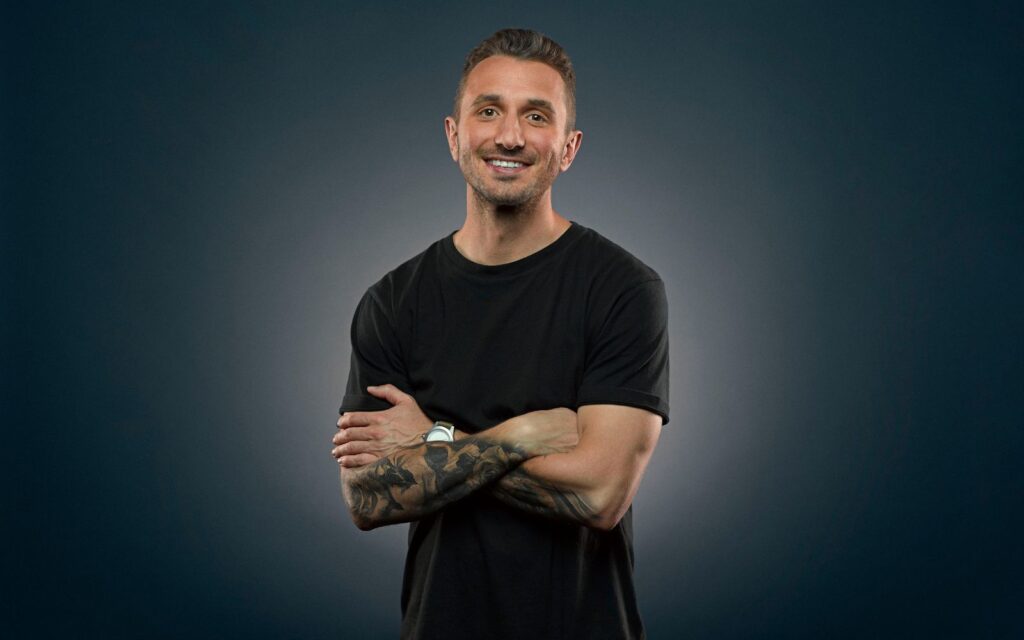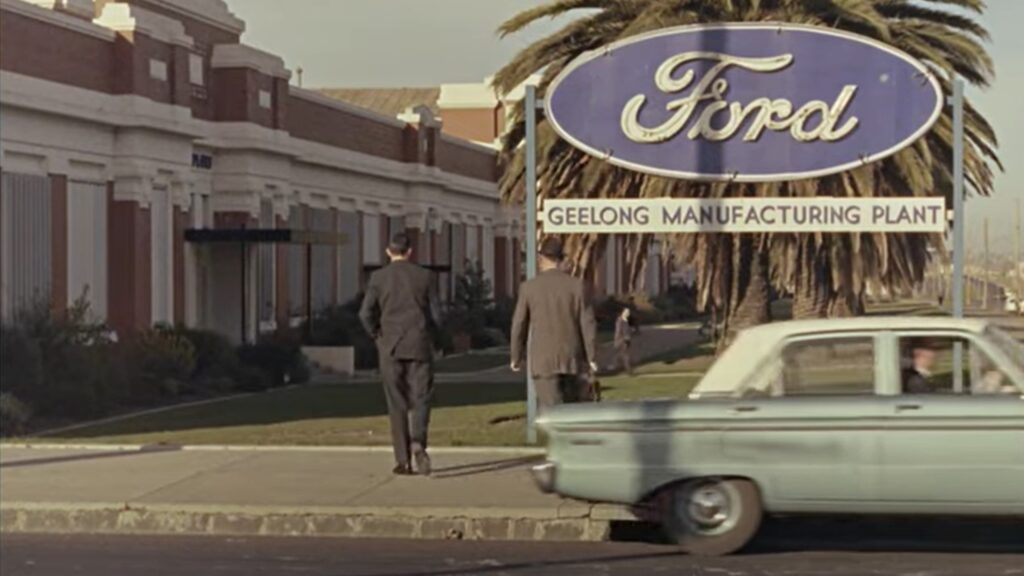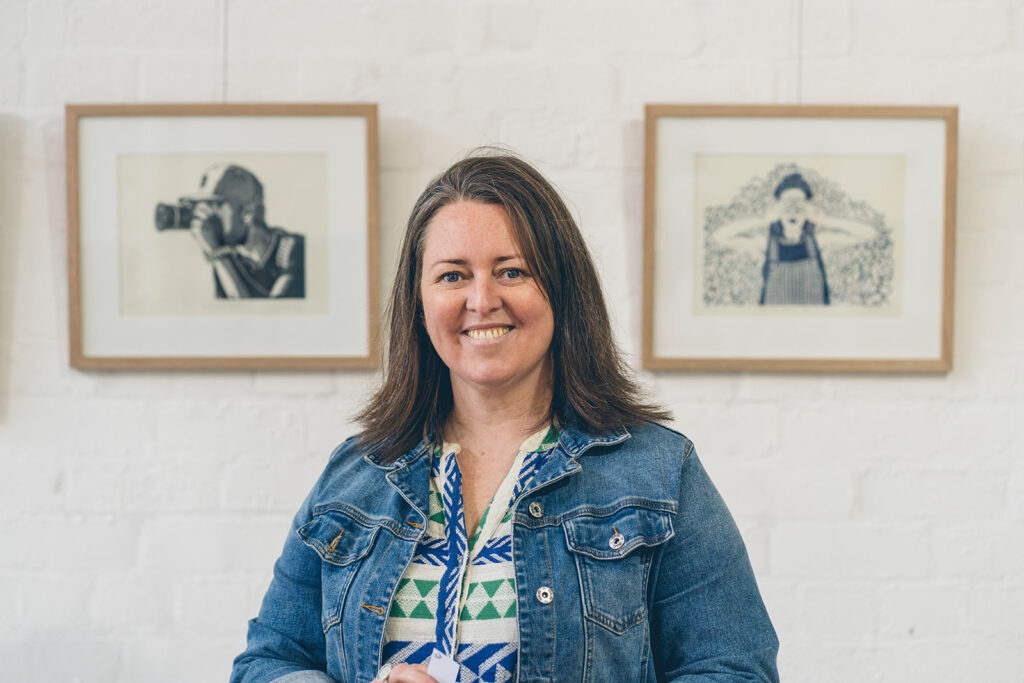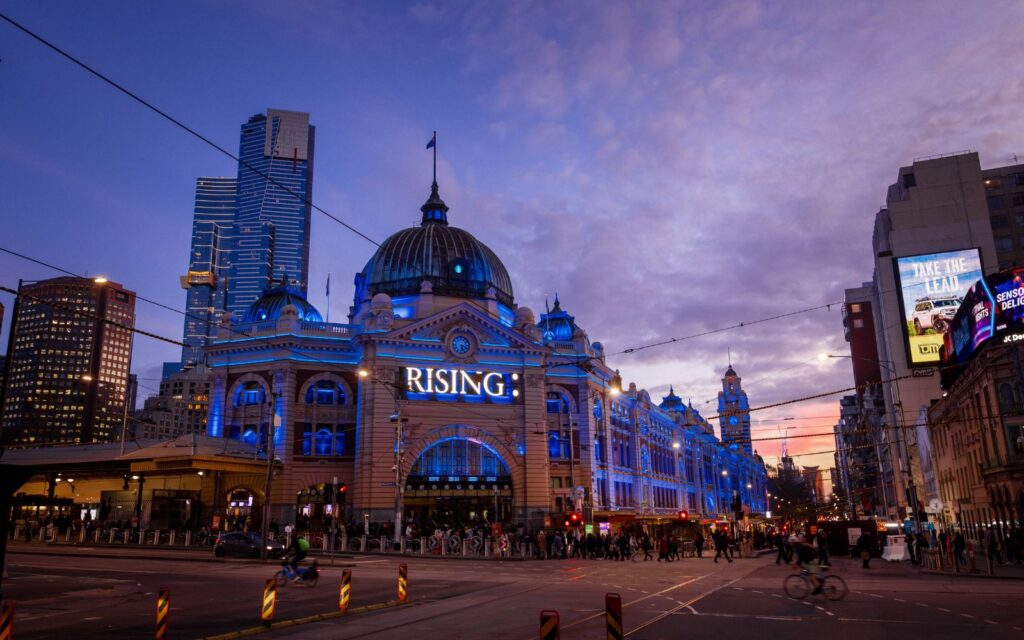For all that 2020 was long and hard, it also prompted some of the most impressive feats of resilience and imagination.
Dance studios pivoted to hosting classes via Zoom. Software designers scrambled to build apps connecting families across the globe. Friends got inventive with how they hung out.
So how have our creatives – who normally thrive on in-person collaboration – adapted? And what has their time in the digital world taught them?
We spoke to the next generation of creatives – the emerging design cohort at Deakin – to find out.
A few weeks before COVID struck, Luke Martin was in New York. He was there to soak up the very best the city had to offer: its sights, its sounds, but most important of all, its Broadway shows.
“I was there for a week and I booked everything I wanted to see in advance,” the third-year design student explains. “Like Hamilton and Dear Evan Hansen. But there were a couple of others that I stumbled into on accident, like with Hadestown, that just completely blew me away.”
The trip was also something of a personal high point for Luke. As an aspiring theatre graphic designer, being in New York meant being at the very heart of a creative environment he hoped to one day join.
At the time, he had no idea the world was on the brink of a global shutdown. But despite the challenges of the year, Luke remains positive about what the future holds. He suggests that while he wouldn’t have thought it at the start, 2020’s provided him with an understanding of how he might evolve as both a collaborator and a creative.
“In the past 12 months, finding ways to collaborate and to get advice and opinions on new and different things has become so much easier,” he said. “There was always a focus on using the collaboration suites in Adobe and that kind of thing, but the focus on collaboration has become so much more.
And all the time I’ve spent online has made me think a lot about possible avenues for design, and where it can step up and become something really impressive – which is to say, in a digital environment.”
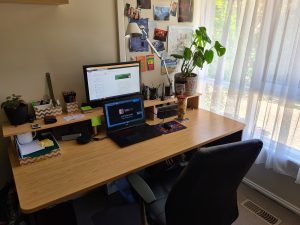
Luke Martin’s desk, where he’s been working and studying from since the pandemic hit.
Image by Luke Martin
Evolving in the new normal
The Head of the School of Communication and Creative Arts, Matthew Delbridge, shares a similarly silver-lined perspective to that of his student. While he describes the shift from in-person classes to online as a ‘challenge’, he also praises the grace and ingenuity with which students.
In particular, Deakin’s staff chose to use the shift to online to explore what the future might hold for their students. While classes were traditionally held on one of Deakin’s four campuses, the likelihood of students working in remote or blended environments in the future was high. Now was their chance to explore topics their students would have to address in their careers, like: what could an artist do to make their CV stand out online? How could design briefs be enhanced in a digital setting? How could an artist find their resolve during challenging times, and continue to create art or foster a creative environment? What would the future need – and how could Deakin’s design students bring it to life?
As an example, Deakin’s first-year design students were challenged to conceive and design an object that existed in both virtual and material dimensions. That way, it could be easily transported to clients through the net – but could also be produced as a real artefact in an instant. Students generated iterations of their chosen object, first as a two-dimensional design, then as a 3D object, then a 3D printable object file, before finally transporting their object into an interactive 3D environment. Elsewhere, PR students were asked to pitch themselves in a minute-long recording (‘Me in a Minute’) in reflection of shifting industry demands.
Often, students projects revolved around or responded to creating under COVID; as Delbridge puts it, the topic was hard to escape. However, as Delbridge also puts it, the constraints also encouraged students to really think about their capabilities and how they could contribute to the world.
‘One of the projects we worked on was designed to address human connectedness during the pandemic,’ says Jasmine Toomes, another third-year design student and one of Luke’s peers. Talking to her, it’s clear the project was born directly out of her own experience under COVID: early in 2020, she struggled with being unable to connect or bounce off her fellow students. ‘There were three teams involved and we ended up designing a Zoom-like app, where sounds played when you walked towards each other so you knew you were there and you could hear each other better; and then when you walked away the sounds faded out.’
‘In a minute’ pitch by Mayy Abuljebain: Design students studying professional practice work with digital media to pitch themselves ‘in a minute’ to the creative world. They address a range of issues about ethics and global citizenship and more.
Forging global connections
The networked nature of 2020 also presented other unexpected, professional opportunities. For all that Deakin espoused a global perspective and international connections, only so many students could make the trip overseas. Now, with everyone working from home, the options for collaboration were a lot simpler.
In one project, students were invited to collaborate with Melbourne landmark Federation Square on a series of xx videos. They received feedback from the team at Federation Square at key stages, gaining on-the-ground training on how to manage stakeholders and collaborate virtually. Selected pieces were displayed at the new Digital Façade in Federation Square. Excited by the high profile opportunity, students threw themselves into their work, producing stellar pieces.
Jasmine and Luke were similarly part of a trimester-long collaboration with Japan, where they were split into three teams and assigned different design briefs.
“It was a lot of late-night and early morning Zooms,” says Jasmine. “One of the students in the team was in Malaysia as well, which meant they were up at all sorts of crazy hours.
“We became aware, pretty early on that we weren’t going to have anyone over our shoulder saying, you need to do this now. So it became clear we needed to set regular daily Zoom meetings and to assign work to each other that’d bring the project along; to be really clear in how you communicate and to use project tracking software or other things, to make sure you’re really staying on target for your deadline.”

A logo created by Luke Martin as part of the Ochugenki “gift box” concept in Screen and Design Industry Project.
Image by Luke Martin, Minh Nguyen and Jenny Phan
Delbridge says that this professional exposure is what Deakin strives to offer his students – and that he’s feeling positive about how these partnerships could be offered online.
“Students that come and study with us spend an element of their degree out there in the industry, creating professional connections in the real world,” Delbridge says. “And that’s a real advantage. Online provides both limitations and opportunities that we haven’t been able to explore before.”
Collaborative Design Project by Abby Christiaans, Sasha Ilott, Ayra Clarke, Sharna Lambert, and Helene Hartung: Design students developing real world skills working directly with designated clients, in teams, to help solve tangible issues that their clients and their audiences face.
A new chapter
Now, at the start of 2021, Delbridge’s thinking about the future and what it might look like and what he’s learnt from the year that’s been.
While Deakin has always been a leading institution in online teaching, 2020 saw the university evolve further, offering live streaming of classes designed to maximise the opportunity of live questions and end-of-lecture small talk, focusing on interpersonal interaction and live communication.
“Deakin’s got a long-standing reputation as being a premier online delivery institution,” Delbridge says, “But we’re, of course, going to go back to face-to-face delivery. There’s no question about that; there are elements of preparing an artist for the world that can only be properly met face to face. But you will see a more innovative and flexible approach to how the content is delivered and we’ll improve on areas where online delivery has worked. You’ll also probably see some more targeted approaches that are online only because of the sorts of things that we’ve learned.
“Normally, for creative students, you would be in a studio making work together with your peers on the floor. That’s the same process has happened this year, but those students have been in a virtual space, working with each other remotely. They’ve been in their own homes or studios. It’s a unique way of working and creating and we would be crazy to get rid of that because the whole world has learned that this opens the door to an international audience,” he continues.
“It’s happening right in front of you. It’s not pre-recorded. It’s a whole different style of management, a whole different style of dramaturgy, a different style of writing, a different style of designing and making. And we would be crazy to toss away the things that we have learnt.”
If you’ve spent the last 10 months at home and you’re ready to scratch that creative itch, or you’ve had the chance to consider what you really want to do … now could be your time to study at Deakin.
If you’re looking to explore your creative skills or chase a creative career, take a look at Deakin’s communication, creative arts and design courses here.
Explore student stories and mini-masterclasses here.



